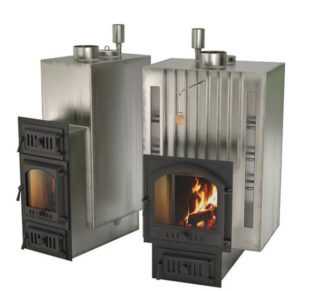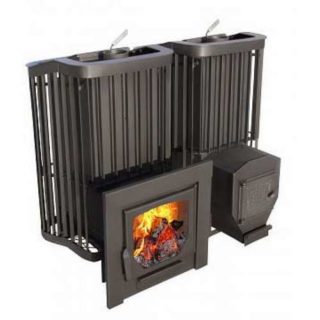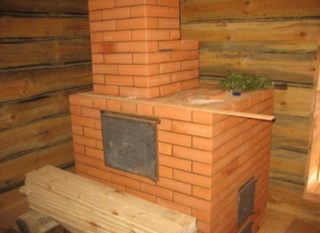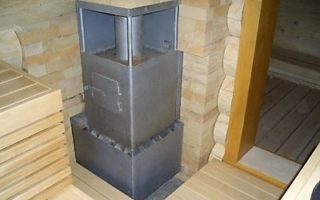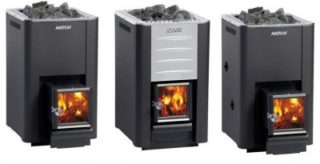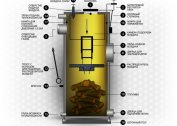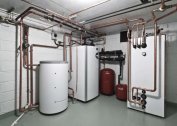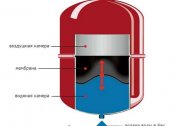The sauna stove with a closed heater is a generator of superheated steam, without which the full functioning of the room is impossible. The construction is characterized by numerous positive characteristics that are appreciated by lovers of the traditional Russian procedure. You can buy a sauna stove with a closed heater in a specialized store and even with installation service. With building skills and a small set of tools, you can do it yourself. To determine the selection criteria, you should familiarize yourself with the features and structure of these structures and the range of products offered for sale.
The device of the furnace with a closed heater
The furnace for a bath with an internal heater works on the principle of a heat accumulator. The stones located inside the chamber quickly heat up, and then instantly give off heat to the steam room. Subsequent heating does not take much time thanks to an efficient heat exchange system. Cobblestones are inside the case and are heated directly by a flame. The appearance of smoke in the room is excluded, since a powerful draft pulls all the combustion products from the boiler into the chimney.
The stove of the sauna heater consists of the following parts:
- Body. The walls are made of one, two layers of metal or brickwork, if the steam room is spacious enough. The thicker the material, the more it accumulates heat and better absorbs infrared radiation. The remote fuel channel is made so long that it can be laid through the wall of the desired thickness. The walls of the convector type housing, due to which the steam room provides a constant circulation of hot air, the same temperature is achieved above the floor and near the ceiling.
- Thermal battery. Represents the stones laid on strong cast-iron grid-irons. Fire passes through them, heating the material, which can heat up to 700 degrees. Another option is to place the stones in a closed steel tank to which a water channel is supplied.
- Steam gun. It consists of pipes through which hot steam is emitted into the steam room after water is supplied to the cobblestones. At the ends of the tubes atomizers can be installed for a better distribution of steam.
- Door for supplying fluid. The product is equipped with heat-resistant gaskets, providing complete sealing after closing. Some models are equipped with transparent sashes, which allow you to create a cozy atmosphere of coziness and comfort in a steam room. Some models are equipped with a built-in water tank. In such designs, the supply of boiling water to the cobblestones is carried out using a nozzle, which is activated manually, as necessary.
- Chimney. Depending on the type of firebox, coaxial or conventional pipes made of stainless steel, ceramic or glass are used.
After the stones are heated during the combustion of firewood, the door opens and water splashes on them. There is a rapid formation of steam, which, leaving through the tubes, fills the entire space of the sauna. There is a rapid jump in temperature, which requires several hours for open-type structures.
Pros and cons of using the bath
Like any heating device, the stove heater for a bath has its own characteristics, advantages and disadvantages.
The advantages of a closed type construction:
- The speed of heating the steam room.The room is filled with steam, due to which a comfortable and useful microclimate is created.
- Fire safety. Since heating is carried out by steam, and not by the incandescent body of the product, in combination with the absence of an open flame, fire is completely eliminated.
- Optimal use of thermal energy. Cobblestones receive it directly from the flame, and not from the walls of the boiler, where there is point contact with the surface.
- Quality steam. At a focus of this type, it is light and dry. The room does not form excessive and heavy dampness, adversely affecting the well-being of a person.
- Maintaining an almost constant temperature. After pouring water, the temperature of the stones almost does not drop and quickly recovers.
- The ability to install in a large area due to high performance.
- Convenient adjustment of temperature and humidity.
Cons are few. The first is the cost of the product, since it has a complex device and requires high precision in manufacturing. The second drawback is relative and is associated with a large consumption of firewood to achieve a qualitative result. But since the bath is infrequently heated, you can safely close your eyes to it.
Characteristics of cast iron stoves
For a sauna, stoves made of cast iron are best suited. This alloy has the positive properties inherent in steel and brick. Cast iron foci are characterized by high thermal conductivity and quickly heat up. Due to the thickness and crystalline structure, the metal is able to retain heat for a long time. High temperatures during the burning of firewood are not afraid of him; you can not be afraid of the product melting and cracking on it.
The disadvantage is that iron has a specific smell, from touching it you can get a severe burn. To make the cast iron hearth safer, it is lined with decorative material in which vents are made. Only the top and space for opening the door are left open.
Brick products also have their own nuances, strengths and weaknesses. The material has a low thermal conductivity, but it accumulates heat well, evenly distributing it throughout the room. Touching a brick can cause pain, but there will be no burn. The downside is that the masonry takes up a lot of space that cannot be allocated in a small steam room.
The best solution is to combine materials. Metal can be walled in order, the brick is placed inside the furnace or outside the hearth.
Furnace Selection Criteria
A stove for a Russian bath is a structure that can make the process of staying in the steam room both pleasant and useful, as well as uncomfortable and meaningless in content.
When choosing a source, you should pay attention to the following criteria:
- production material (cast iron, heat-resistant steel, combination);
- product dimensions, compliance with the size of the steam room;
- power output;
- surface heating temperature;
- type of fuel and its nominal consumption;
- the option of supplying water to the stones (straight through the fitting);
- body type (convector, monolithic);
- furnace weight (need reinforcement of the foundation or not);
- additional options;
- appearance;
- installation method (independently or with the assistance of specialists);
- the possibility of modification.
It is worth considering that stoves with closed stoves have a different price range, depending on the country of production and the complexity of the design. This factor must be taken into account.
Do-it-yourself stove with a closed heater
The decision to make a stove with your own hands will save a considerable amount and realize all your engineering decisions. To do this, you need to draw up a competent and well-thought-out drawing, without missing a single trifle.
To work, you need such tools and materials:
- welding machine, grinder, electric drill;
- wrenches, a set of screwdrivers;
- collapsible grates;
- heat resistant steel with a thickness of 2, 6, 8 and 10 mm;
- chimneys;
- tubes and nozzles for the steam generator or the finished product in the kit;
- handles, hinges, latches;
- hardware (bolts, nuts, rivets);
- heat resistant sealant.
The work is carried out in the following sequence:
- Making the foundation. It is cast from concrete with a reinforcement cage. The top is covered with waterproofing.
- Steel is cut into patterns corresponding to the size and configuration of the parts of the body.
- Parts are welded into a single structure.
- Cobblestones are loading. Depending on the size of the stove, they will require 300-500 kg.
- Finishing work is being carried out. Decorative stone, clinker tiles or bricks are used.
In conclusion, a control furnace is carried out, at the end of which the detected assembly defects are eliminated.
Popular manufacturers
The most popular today are such models of domestic and foreign manufacturers:
- Harvia M2;
- Hephaestus PB-04 MS;
- Harvia M3 SL;
- Vesuvius Skif Forging 22;
- TMF Geyser 2014 Inox;
- TMF Vitruvia Inox;
- Barbara Therma-Kamenka.
Stoves should be purchased in company stores after checking the availability of a quality certificate.
